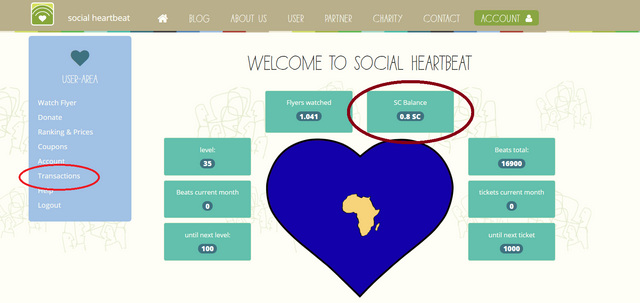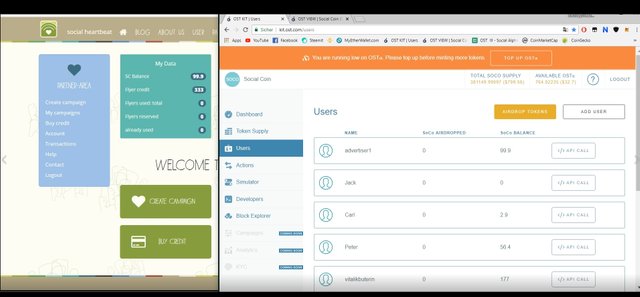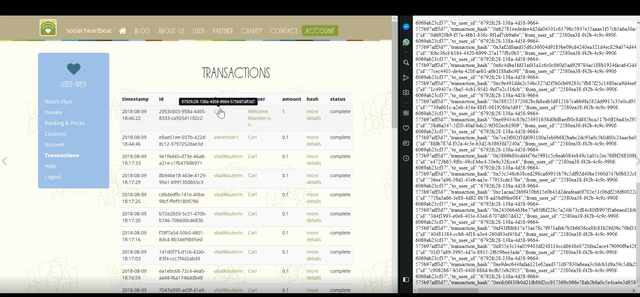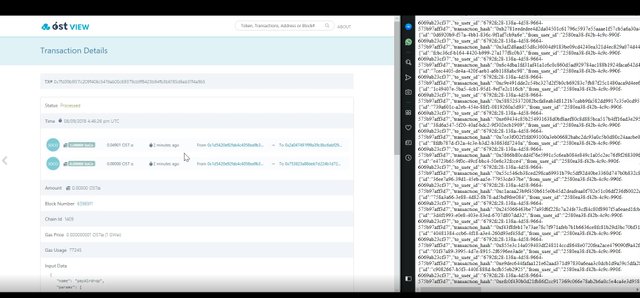Social Heartbeat - Final blog post and POC for the OST KIT Alpha III Phase - Embedded Wallet-Lite developer challenge
Fellow Steemians!
This is the final blog post for our participation in the OST KIT Alpha Phase III - Embedded-Wallet-Lite developer Challenge.
We integrated our own branded Token, named "Social Coin", into our Web-App „Social Heartbeat“ using the OST APIs. One of the main features in this particular challenge was the integration of the OST Ledger and Balance APIs, which allowed us to display the users transaction history and token balance in the users interface within the app.
What is Simple Token(www.ost.com)?: " At OST, we are building essential blockchain infrastructure and developer toolkits to enable any business — no matter their size or level of technical sophistication — to benefit from having their own Branded Token economy without the hassle, costs, and risks of an ICO. Tokenization will help businesses increase customer engagement, growth, and monetization, allowing them to invest more in their community ecosystem and reduce reliance on third-party acquisition and re-engagement from the likes of Facebook and Google. "
Watch our POC-Video for a full demonstration:
1) What problem does your project solve and what was the user need for creating your token economy?
Social Heartbeat is a web-app that offers advertisers a platform to effectively reach their targeted audience. A part of the revenue is donated to local charities. We launched our beta in Münster, a city in germany that is well known for its many students.
Advertisers use printed paper-flyers and posters to promote their events and products. This is very costly, inefficient and harmful to the environment. Our users can access the web-app and watch the flyers on their smartphones. They gain information about local parties, events and special offers of local businesses. This way they stay informed and get to know their city, while profiting from special offers, saving the environment and supporting local charities at the same time.
From the very start we were facing the problem of how to incentivise our users to use our web-site and reward them for their activities. Ideally we wanted to let the users earn part of the revenue directly and then decide for themselves to which charitiy the money should be donated. However integrating a system for Fiat money is (legally)challenging and very expensive to integrate, not to mention the cost of maintaining and executing. As a start-up with limited funds we could not do this.
Thats why we had to choose a different solution which was not as satisfactory, because users did not get rewards of real value. The just received points, which were used for tickets to our monthly lottery, where users could win giftcards and prices.
As a result the incentive to use our app was mainly of informational purpose and the will to save the environment and to support charities by watching ads. This however attracts only a very particular group of people, so we needed a solution that appeals to the masses.
Using a branded token econmy on OST gives us a solution, that's easy to implement, cheap to execute and perfect to reward our users and incentivise them with real value. Now users earn tokens for watching the ads, which can then be donated to charity and later on be spend at partnering businesses or across the whole OST-ecosystem. A user could earn tokens in our app and spend them for a coffee in the next coffee bar.
2) What was your key goal behind doing the challenge?
Since integrating a branded token economy into our app is a reasonable option for us, our main goal was to test the feasability of the integration. We wanted to get to know the API calls and features of the OST developer tools in order to explore our options for the app and get used to the software for later use. I personally am invested in Simple Token and participated in the crowd sale in 2017. I want this project to succeed because i think it has one of the strongest usecases in the whole industry with the potential to disrupt the industry and enable mass adoption of blockchain technolgy. By participating and showcasing our integration, we can hopefully do our part by calling the attention of more companies and prove to them how easy and beneficial the integration and use of the OST platform is. That's why i encourage everyone to test the platform and its tools and give valueable feedback, so that the OST-team can learn and improve.
3) How did you plan the design for your wallet features?
The user dashboard has a clean visual structure with specific displays for the most important stats (see screenshot 1). We planned to design in a way that it does not interfere with our previous structure, which is clean and easy to navigate.
Knowing their token balance is one of the key desires of our users. That's why we displayed the token balance right on the main page of the users dashboard. Since we already had a clear structure within our app, we implemented the transaction history into our menu, so that it's easy to find and the user has a seperate site, dedicated for all the numerous transactions.
4) What APIs did you use: Ledger, Balance, Actions, Token Details, etc.?
Social Hearbeat (SH) uses the OST REST APIs to combine the features of SH with a branded token economy. In the OST KIT ALPHA II challenge, the User, Action and Transaction API were used to implement the basic features of the SocialCoin economy. Users in SH were automatically given a counterpart on the OST blockchain. The user actions of buying flyer packages, watching flyers and giving money to charity were then mapped to Action & Transaction calls on the OST API. In the users dashboard the current balance of Social Coins was retrieved with the help of the Users API. This part was then changed in the latest OST Alpha III challenge, as of now the balance view is implemented over the Balance API. To give the SH users an overview of their actions and transactions on the OST blockchain the new Ledger API is used.
5) What information did you show to the end user and why and how did you use design (UX/UI) for how to display this information?
The token balance is displayed on the main page of the users interface, because it's one of the most important information.
The information shown in our transaction overview is converted from the SH backend via PHP to a human readable form. The unix stamp becomes a readable time and date, the user IDs are mapped to the users on the SH platform.
We dedicated a whole page to the transaction history and put it into the menu. The transactions become numerous thats why we cant display them on the main page without causing confusion and affecting the UX negatively. We want our interface to be as simple and easy to navigate as possible.
We also displayed just a few of the given information. Most users will only want to know when they send their tokens and how many tokens they send to whom. More details can be accesses when clicking on the „more details“-link. This will guide the user to the OST View page which shows all transactions on the blockchain and gives all information, like gas price, block number etc. This was our way of streamlining the information for a good user experience.
6) What did you like about using these APIs?
The APIs are well documented and simple to use. So far everything worked as described, which is definitely not always the case. Thanks for the good work!!!
7) What did you learn about designing these wallet features?
Giving the user the information he/she needs is necessary to build trust with a new platform. The overview over single transactions and how everything is processed and connected to an underlying technology is only possible with the new wallet features. This gives the users enough insight into the whole process, which in turn leads to a good user experience. It's important to understand that the information retrieved by an API call must be processed and displayed in a user friendly way, since most information are only for the tech-savvy people and hinder a good UX. With each new challenge and the new API calls we were able to deepen our understanding of the OST APIs and the funtionality of the OST platform.
8) Screenshots:
A Users dashboard with the newly implemented token balance and transaction history
https://pasteboard.co/Hyw1zfj.png

Users (advertiser) token balance shown in the App and in the token economy on OST KIT

Transaction history of a user within the app: Carl donated 1 SocialCoin to a charity!

Carls donation verified on the OST View block explorer (Time difference: Social Heratbeat-Server: UTC+2)
https://pasteboard.co/HyvZTaq.jpg

We are eager to keep building and supporting the process of the OST platform and its team! We are proud to be part of this and can't wait to see it become the global standard for tokenizing businesses and leveraging the advantages of blockchain technology.
Thanks for reading and best wishes from,
Leon, founder of SH, and Tom, developer of SH.


Congratulations @embutv! You have received a personal award!
Click on the badge to view your Board of Honor.
Do not miss the last post from @steemitboard:
Congratulations @embutv! You received a personal award!
You can view your badges on your Steem Board and compare to others on the Steem Ranking
Do not miss the last post from @steemitboard:
Vote for @Steemitboard as a witness to get one more award and increased upvotes!